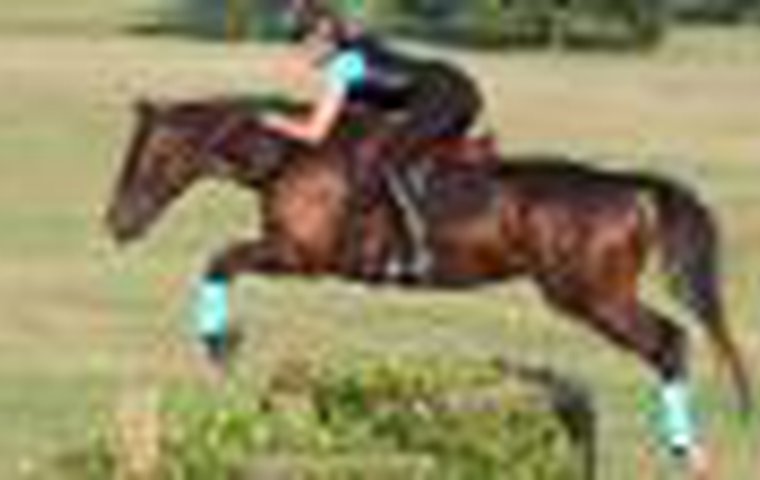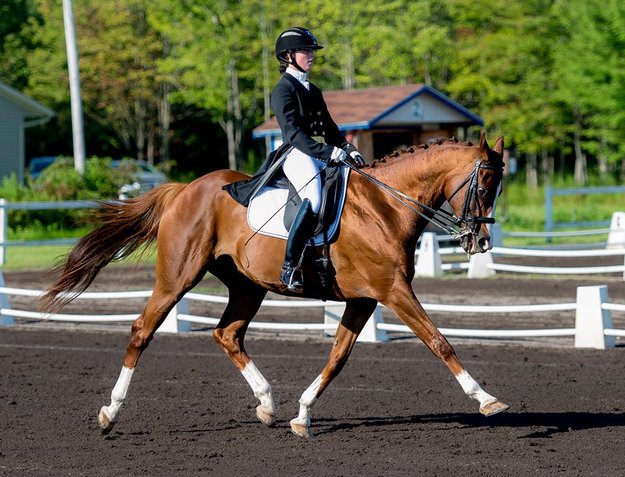
Simply retiring a horse when his prime racing days have passed is fraught with complications; main concerns include cost of long-term care (horses can live upwards of 25 years), location of a suitable facility, and assurance that the horse is being cared for properly. Adoption, on the other hand, offers myriad options for successful second careers; it places no additional financial or emotional burden on the owner or breeder. These second-career choices, however, hinge on one key element: That the horse is retired from racing while still sound. Sarah Coleman, soon-to-be director of education and development for New Vocations Racehorse Adoption Program in the United States, explores the importance of soundness for a successful second career.
Placing a racehorse in a new home is significantly less complicated when he is retired sound; there are many people out there searching for their next sport horse, trail partner, or carriage-driving star. However, these potential owners will only consider horses that come off the track healthy enough to enter into new vocations.
Thoroughbreds are bred to do a job: run. While people may think that retirement in a pasture sounds like a lovely choice for a horse that has paid his dues on the track, they fail to realize that this breed craves not only a routine, but interaction with humans. The vast majority of Thoroughbreds enjoy having a purpose, even if that is simply to amble along trails a few days a week.
Adoption focuses on training a horse for a job after the track. Horses suitable for adoption might be retired sound, but they may also have injuries from which they are able to heal, usually with rest and rehabilitation, and be ridden.
There is a spectrum of “soundness.” Some horses have injuries from which they have fully recovered that permanently prevent them from jumping or being ridden heavily. Other horses, either those who have retired sound or those who have rehabbed from injuries such as knee chips (only if removed) or bowed tendons, can be used for any discipline or endeavor, including jumping, driving, endurance, dressage, trail riding, and more.
WHEN IT'S TIME
Many trainers lay hands on each of their Thoroughbreds every day; in addition, some of the larger stables have a dedicated team of managers, grooms, and riders with whom they entrust the care of the horses.
If heat, shortness of stride, or general unwillingness to work is noticed, a veterinarian should be consulted. If it’s determined that the cost of care or the time involved to bring the horse back to complete soundness is too great, the newly retired racehorse still has options.
Nancy Koch, a 14-year veteran with the Communication Alliance to Network Thoroughbred Ex-Racehorses (CANTER) Ohio, says that CANTER can adopt out any sound horse. It is also fairly easy for CANTER to “adopt out horses that have small problems, like the need for surgical interventions for chips or bowed tendons.” It is significantly harder to find homes for those who have had too many or significant injuries to have a second career.
“All these horses [with small problems] need is time, which is hard to come by at a track,” Koch said. “The hardest to place are those horses who are not necessarily sound—their options are limited.”
It is imperative for owners and trainers to understand that a lack of soundness after racing is the main impediment to horses finding a successful second career.
By encouraging both trainers and owners to investigate why a horse is off, before a potentially catastrophic event occurs, and then make an educated decision for its future, it becomes even more possible to find an outcome that is in the best interest of both the horse and humans involved.
There is also a financial incentive to retiring horses before they break down.
Anna Ford, program director for New Vocations Racehorse Adoption Program, said that she “definitely encourages owners and trainers to cut their losses earlier rather than later. Many times when a horse starts dropping in class, it ends up costing the owner less to retire the horse while it is still sound [than to keep it] running in hopes that it gets claimed or happens to improve. In most cases, the horse isn't able to improve and win, thus costing the owner several more months in training.”

HOW TO PLACE A HORSE
As an owner or trainer, there are quite a few ways you can help a Thoroughbred find a quality second career.
These include:
1. Locate a reputable adoption organization. There are myriad adoption agencies, but locating one you are confident in could prove to be a challenge. In the United State, one resource to utilize is the Thoroughbred Aftercare Alliance (TAA), a newly formed entity that serves as an accrediting body for Thoroughbred aftercare facilities. As all organizations must meet a strict code of standards in order to receive funding from the TAA, owners can have great faith that the entities listed are legitimate and trustworthy. You can find a list of TAA-accredited agencies here.
2. Get the word out. Never underestimate the power of word of mouth. Mention to your vet, farrier, and stable help that you have a horse that is ready for a new career. Be honest about potential limitations and make sure you or someone on your team familiar with the horse is available to field calls or emails of interest.
3. Find social media sites where you can list your horse. Many state, local, breed, and discipline organizations have Facebook pages where you can list your horse for free
4. Give your horse to a reputable trainer. If you need not recoup the loss of money, give the horse for free to a non-racing trainer who can prepare him for a second career.
5. Locate a layup facility where the horse can hang out for a bit. If you have the ability, locate a quality farm (or your home farm) for turnout, let down, and rehabilition.
For any of these options to work, it’s important to have at least one clear photo taken from both sides of the horse, and preferably from the front and back, as well. If you have them at your disposal, it’s nice to have registration papers and any pertinent vet information on hand should the adoption agency or a potential new owner have questions.
HAPPY TRAILS
Thankfully, there are now a plethora of options available to owners and trainers looking to rehome a retired Thoroughbred. The key factor to any successful rehoming, however, is that the horse be retired from racing either sound or with an injury that is easily rehabilitated. Retiring a sound horse can alleviate both the financial pressure on owners and trainers, and lessen the possibility of a horse ending up in a bad situation by falling through the cracks.
---
Based in Lexington, Ky., Sarah adores her OTTB "Iggy" (Bayou Brass) and competes in the 3-foot hunter and adult equitation divisions.


